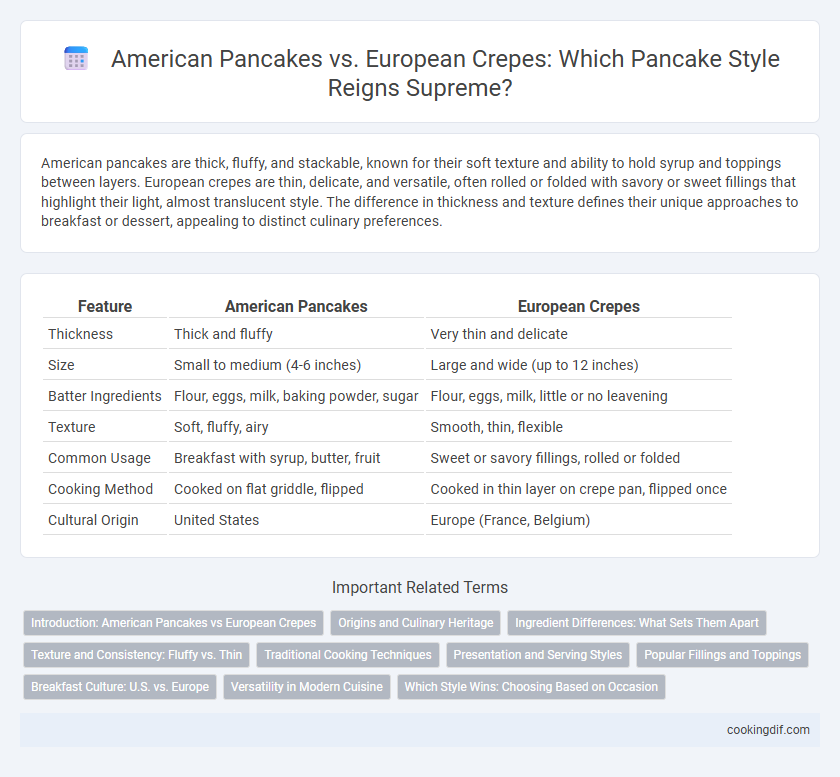American pancakes are thick, fluffy, and stackable, known for their soft texture and ability to hold syrup and toppings between layers. European crepes are thin, delicate, and versatile, often rolled or folded with savory or sweet fillings that highlight their light, almost translucent style. The difference in thickness and texture defines their unique approaches to breakfast or dessert, appealing to distinct culinary preferences.
Table of Comparison
| Feature | American Pancakes | European Crepes |
|---|---|---|
| Thickness | Thick and fluffy | Very thin and delicate |
| Size | Small to medium (4-6 inches) | Large and wide (up to 12 inches) |
| Batter Ingredients | Flour, eggs, milk, baking powder, sugar | Flour, eggs, milk, little or no leavening |
| Texture | Soft, fluffy, airy | Smooth, thin, flexible |
| Common Usage | Breakfast with syrup, butter, fruit | Sweet or savory fillings, rolled or folded |
| Cooking Method | Cooked on flat griddle, flipped | Cooked in thin layer on crepe pan, flipped once |
| Cultural Origin | United States | Europe (France, Belgium) |
Introduction: American Pancakes vs European Crepes
American pancakes feature a thick, fluffy texture achieved by using baking powder, creating a spongy base ideal for absorbing syrup and toppings. European crepes are thin and delicate, made from a runny batter without leavening agents, resulting in a light, flexible canvas often filled with sweet or savory ingredients. The distinct preparation methods highlight regional culinary preferences, emphasizing volume and softness in American pancakes versus thinness and versatility in European crepes.
Origins and Culinary Heritage
American pancakes, characterized by their thick, fluffy texture, originate from early colonial influences combining Native American corn-based recipes with European techniques, emphasizing a hearty breakfast tradition. European crepes, particularly from France, trace back to medieval Breton cuisine, showcasing a thin, delicate style designed for versatile sweet or savory fillings. These distinct culinary heritages reflect regional ingredients, cooking methods, and cultural preferences that define their unique place in global gastronomy.
Ingredient Differences: What Sets Them Apart
American pancakes feature a thicker, fluffier texture achieved through the use of baking powder and a higher ratio of flour to liquid, often incorporating eggs, milk, and sugar for a rich, sweet flavor. European crepes are thin and delicate, made from a simple batter of flour, eggs, milk, and a pinch of salt, with no leavening agents, resulting in a pliable, light consistency ideal for savory or sweet fillings. The key ingredient differences lie in the presence of leavening agents and the ratio of wet to dry ingredients, shaping their distinct textures and culinary uses.
Texture and Consistency: Fluffy vs. Thin
American pancakes boast a fluffy, airy texture achieved through the use of leavening agents like baking powder, resulting in a thick and soft consistency. European crepes feature a thin, delicate texture with a smooth and pliable consistency, made from a batter without rising agents. The contrast in texture highlights American pancakes as a hearty breakfast staple, while crepes offer a light, versatile option for sweet or savory fillings.
Traditional Cooking Techniques
American pancakes rely on a leavening agent such as baking powder to achieve their thick, fluffy texture, while European crepes are thin and delicate, made from a batter of eggs, flour, and milk without rising agents. Traditional American cooking techniques involve pouring batter onto a hot griddle and flipping once bubbles appear, creating stacked layers often served with syrup or butter. European crepe preparation emphasizes a thin, even spread in a specialized pan called a crepe maker or a flat skillet, cooked quickly on both sides for a soft, pliable result ideal for savory or sweet fillings.
Presentation and Serving Styles
American pancakes feature a thick, fluffy texture often stacked high, served with butter, maple syrup, and toppings like berries or whipped cream, emphasizing a hearty, layered presentation. European crepes are thin and delicate, typically folded or rolled with sweet or savory fillings, offering a refined, elegant appearance on the plate. The serving style of American pancakes focuses on volume and richness, while crepes highlight minimalism and versatility in presentation.
Popular Fillings and Toppings
American pancakes are thick and fluffy, commonly topped with butter and maple syrup or filled with blueberries and chocolate chips for a hearty breakfast. European crepes are thin and delicate, often filled with sweet options like Nutella, powdered sugar, fresh berries, or savory fillings such as ham, cheese, and spinach. Both styles offer diverse popular fillings and toppings that cater to sweet and savory preferences, making them versatile for different meals and occasions.
Breakfast Culture: U.S. vs. Europe
American pancakes are thick and fluffy, often stacked high and topped with syrup, butter, and fruit, reflecting a hearty breakfast tradition focused on indulgence and energy. European crepes are thin, delicate, and versatile, commonly filled with sweet or savory ingredients, embodying a lighter, more refined breakfast culture emphasizing variety and finesse. This contrast highlights differing priorities in morning meals: robust sustenance in the U.S. and elegant simplicity in Europe.
Versatility in Modern Cuisine
American pancakes feature a thick, fluffy texture ideal for absorbing syrups and toppings, making them a versatile breakfast staple in modern cuisine. European crepes, known for their thin and delicate structure, offer adaptability for both sweet and savory dishes, ranging from desserts to main courses. This versatility allows chefs to experiment with fillings and presentations, enhancing their appeal across diverse culinary traditions.
Which Style Wins: Choosing Based on Occasion
American pancakes boast a fluffy, thick texture ideal for hearty breakfast occasions, while European crepes offer a thin, delicate base perfect for versatile sweet or savory fillings during elegant brunches or desserts. The choice depends on the event's tone--American pancakes suit casual, family-friendly settings, whereas crepes excel in refined gatherings requiring sophisticated presentation. Flavor adaptability and serving style often determine which pancake style wins for any given occasion.
American pancakes vs European crepes for style Infographic

 cookingdif.com
cookingdif.com